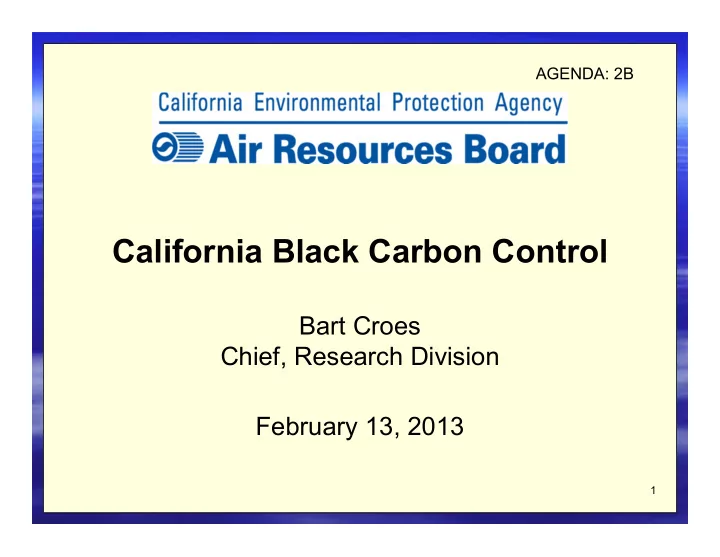

AGENDA: 2B ������������������������������� Bart Croes Chief, Research Division February 13, 2013 1
����������������������������������� California Estimates Pollutant Annual Deaths* PM2.5 7,300 to 11,000 Ozone 300 to 1000 Toxic Air Contaminants <400 * 2006/2008 for PM2.5; 2005 for ozone and TAC 2
�������������������������� ����������������������� 10 �,�� ���� �!��"#�$���%���� 11°F 9 11 ������������ 10 8 9 "��������������������� 8 7 7 �&'�(�������������������� 6 �������������)���������� 5 &��� ��(�*��� 4 4 3 ���)�������(������%� ��������(�����( 2 3 1 &�(���+(���(���������,-- 0 2 ./���(�������������)��(����� � 1 1�����2����������3��������4� ���0������!������.������$ 0 Cal/EPA/OEHHA, “Environmental Protection Indicators for California” (2002), ������������������������������������������������ 3 Westerling et al., “Warming and Earlier Spring Increase Western U.S. Forest Wildfire Activity”, ������� (2006)
���:����(������������������������������;�&�"�/&�,, !����������(�)�����,<�/�,,�$ Sea Energy Sierra Level Demand 10 Snowpack 9 =�%����6�����%� 8 7��%� !9�8 ���-�# $ ,�'����� &&/��> &�' 7 6 5�(����6�����%� 5 7��%� !-�-�8 9�# $ 4 "�/9�'� �./&&> ��' ���� 3 2 1�)���6�����%� 7��%� !�� � -�-�# $ 1 ��/<�'� </�.> �/<' 0 ���� � 4 Our Changing Climate: Assessing the Risks to California (2006), ������������������������
�����������?��%��� ����@������ By 2020, attain annual PM2.5 of 12 Dg/m 3 By 2023, attain 8/hour ozone of 80 ppb By 2025, attain 24/hour PM2.5 of 35 Dg/m 3 By 2032, attain 8/hour ozone of 75 ppb ���������(� ���%���?�������� By 2020, diesel PM risk 85% below 2000 levels 2����������2���� By 2020, reduce to 1990 levels By 2050, 80% below 1990 levels 5
������������������ • Long/lived – Carbon dioxide: 100 years – Nitrous oxide: 114 years – Controls essential to limit global warming • Short/lived – Black carbon: 1 to 2 weeks – Methane: 8 to 12 years – Hydrofluorocarbons: 1.4 to 14 years – Controls produce rapid climate response 6
B����/����(������������������� ������������������A�������� Global (current) California 1��%/����(������������������� 7
������������������ • Black Carbon – Diesel engine controls, Advanced Clean Cars, burning restrictions • Methane – Landfill controls, oil and gas regulations, dairy digester offset protocol • Hydrofluorocarbons – Refrigerant Management Program, Advanced Clean Cars, other regulations 8
.��3�����������%�������������������� Kirchstetter et al. (2011) Black Carbon and the Regional Climate of California, 9 CARB Contract No. 08/323
�������7����7�(����������� (By 2020, reduce diesel PM risk 85% below 2000 levels) • 2007 new engine standards (90% control) • Low/sulfur (15 ppmw) diesel and alternative fuels • Retrofit/re/power with incentives ($500M / year) • International Diesel Retrofit Advisory Committee • Anti/idling measures • Enforcement programs )))��������%��+(�����+(������������ 10
��/C����������7�%�������� Urban Buses (2000) Drayage Trucks (2007) Garbage Trucks (2003) Off/Road Vehicles (2007) Stationary Engines (2004) Trucks and Buses (2008) Transport Refrigeration Units (2004) Tractor/Trailer GHG (2008) Portable Engines (2004) Transit Fleet Vehicles (2005) Public Fleets & Utilities (2005) Cargo Handling Equipment (2005) 11
���%���?���������?�(��D ����������������B����)�(��A�������� 12
�(����(��7�� ���%���7�%�������� � Cleaner diesel fuel rules � Statewide truck rules � Port and railyard truck rule � Truck/trailer efficiency rule � Truck idling and refrigeration unit rules � Ship fuel and shore power rules � Harbor craft rules � Cargo equipment rule � Locomotive/rail yard agreements 13
����������E������������%��� 85% black carbon reductions from 1990 levels Achieved by: • Emissions standards • Fuel rules • Fleet rules 14
�������������A��������7�(������������� ?������F�������%������������F�����( ������ � ��������� ���������������� ��������� Dallmann et al. (2011) ���������������������������������� , 45, 10773/10779 15
=�%��A������%�=����/�����?����� • 809 trucks sampled July 2010 – Caldecott Tunnel (4% grade) • BC emissions lowered 37±10% from 2006 • 10% dirtiest trucks emitted half total BC Dallmann et al. (2012) ���������������������������������� , 46, 8511/8518 16
1�%��/�����2��������G������� ( Gasoline Direct Injection versus Port Fuel Injection) PFI: Very little BC GDI: BC comparable to diesel GDI: PM Analysis ���� F�%����� ������ A��������� ������ 17
�����������?���������5�B���(��(� (passenger cars, light trucks < 8,500 lbs. GVW) Gasoline vehicles subject to PM standard beginning in 2004 18
�����������������%�7����������� • Agricultural burning � Sacramento Valley reduced 90% since 1990 � San Joaquin Valley reduced 80% since 2002 • Residential burning � Mandatory programs in most urban areas 19
�������������A��������� (excludes wildfires) 2010 F��������' F������"' ������%� ,' ������%�<' 5���%�(� ������%��' 5���%�(� 7���(������� ������%��<' &-' Transportation Transportation 58% 57% 7���(������� ��' California San Francisco Bay Area BC ~ 18,200 tons per year BC ~ 2,400 tons per year 20
�������� �����%����������������� ��(����)�������� Observationally Constrained Data More atmospheric heating in southern (Watts/m2) California, in part due to more diesel BC and less clouds Ramanathan et al. (2013) Black Carbon and the Regional Climate of California, CARB Contract No. 08/323 21
B������ • Black carbon contributes to both air pollution health and climate change problems • Diesel engines primary source in California – Factor of 3 reduction observed past 40 years – Factor of 3 reduction expected next 20 years • Light/duty PM standard lowered to prevent black carbon increases from GDI engines • Agricultural and residential burning controls likely reduced both black and brown carbon 22
�������B��(�� 23
�������������������������� • Product of combustion of fossil and biomass fuels • Aggregate of small spheres • Insoluble in water and organic solvents • Strongly absorbs visible light It looks like this under a It looks like this under a very strong microscope very strong microscope 24
Black Carbon Climate Impact 25
Recommend
More recommend